Florence Travel Guide: 16 Best Things To Do & See
Everything you need to know about Florence in Tuscany, including what to do & our top tipsThe most beautiful city in Italy
Ciao Firenze!
Florence, Tuscany’s capital, is home to some of the world’s most iconic landmarks, yet there is even more to explore if you visit the gorgeous city.
Delicious gelato, lively squares and ancient buildings – what more can you ask for?
The city offers so many incredible things to do and see that you can easily stay in Florence for months.
Walking through the old streets amidst magnificent churches, captivating architecture and renowned art galleries is an experience in itself.
We visited Florence for four days on a road trip through Italy and enjoyed every moment. Yes, we will even dare to say that Florence is the most beautiful city in Italy!
In this travel guide to Florence, we’re sharing all you need to know about the best things to do and see (sights, landmarks, viewpoints…), where to stay, how long to stay, the best places to eat, when to visit, how to get around, our best travel tips and much more.
Our favourites: Where to stay in Florence?
- Luxury: The Place Firenze – An absolutely exquisite 5-star hotel with the best location in the city.
- Value for money: Drom Florence Rooms & Apartments – Spacious rooms in cosy Oltrarno with nice green surroundings.
- Budget: Poggio Baronti B&B – From here, it’s a 20-minute bus ride into Florence. In return, you will get a cheap and comfortable stay.
Search for the cheapest and best hotels in Florence here.
Table of contents

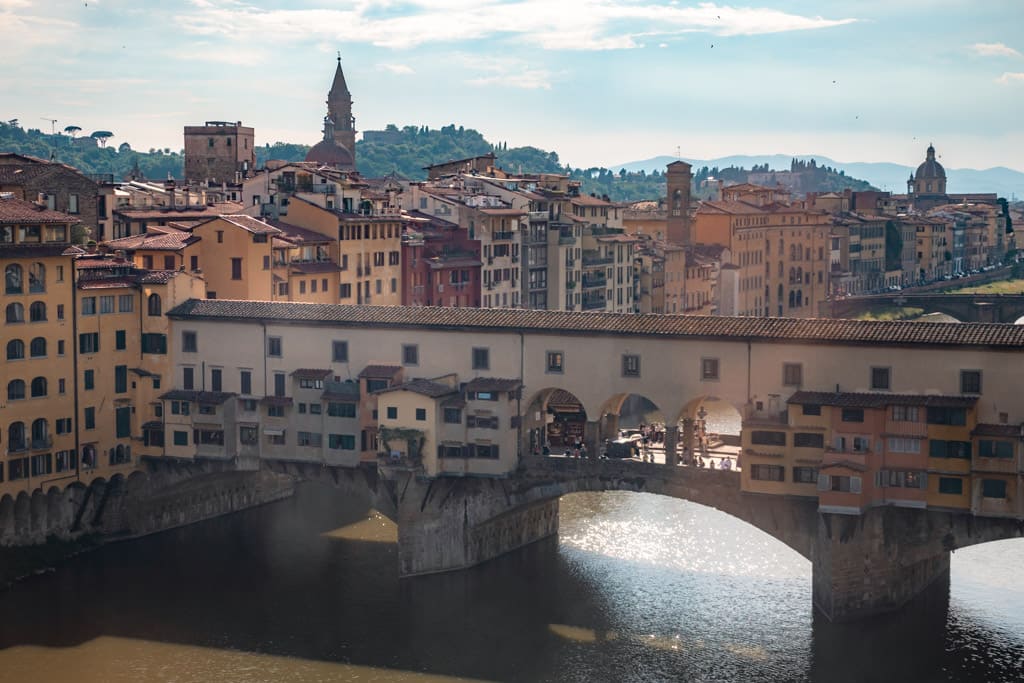
Florence map and geography
Beautiful Florence is located in central Italy and is the capital of the region called Tuscany.
With almost 1 million inhabitants in the metro area and ~365,000 inhabitants in the city itself, Florence is also Tuscany’s most populous city.
Florence lies in a valley surrounded by hills and the River Arno (plus a few smaller rivers) run through the city.

How long to stay in Florence
How many days you should spend in Florence depends entirely on your needs and travel plans.
Many people visit the city on a day trip, e.g. from Rome or Pisa – or they stay for a single night on a drive through Italy. But that is almost a sin in our eyes.
You certainly won’t be bored on a weekend trip to Florence, but consider extending your stay to three, four, or five days for an even richer experience.
We stayed 3 nights in the city and spent 4 full days rushing around to experience as much as possible. We could easily have used a day or two more.
If accommodation wasn’t so expensive in Florence, we could imagine it would be a nice city to live in as a student or digital nomad.
We get into the best places to stay in Florence further down in this travel guide (including advice on where to stay on a budget).



Firenze Card
Firenze Card Official Museum City Pass is a physical card that is valid for 72 hours and gives free access to all of Florence’s 60 (!) museums.
The Firenze Card is the city’s official tourist passport, and with it in hand, you get free entry to, among other things, The Uffizi Gallery, The Accademia Gallery and Brancacci Chapel (the “Sistine Chapel of the early Renaissance”).
Some of Florence’s biggest highlights in other words.
Without paying individual entrance fees for each museum, you might find yourself drawn to explore some of the city’s smaller museums, each offering equally enriching experiences.
At various locations, presenting your card at the entrance allows you to bypass queues entirely – a valuable perk, particularly during the bustling summer months.
If you want to see prices and check out which museum entrances and other benefits are included, you can read more about the Firenze Card here (adlink).
Tip: Children under 18 enter for free with an adult who has a Firenze Card.
Advertisement
The 16 best things to do and see in Florence
Florence is such a beautiful city full of exciting things to do and see for everyone who is just remotely interested in culture, history, art or great food.
And even if you aren’t, pretty much everyone will enjoy strolling around the cosy streets of the historic centre.
Here are what we believe to be the best things to do and see in Florence including attractions, sights, landmarks and viewpoints.
The 16 best things to do and see in Florence:
- Centro Storico – The historic centre
- Il Duomo – The iconic cathedral of Florence
- Palazzo Vecchio – A city hall with a panoramic view
- Piazza della Signoria – Beautiful square with a replica of Michelangelo’s David
- Ponte Vecchio – Historic bridge with coloured houses
- Piazzale Michaelangelo – The best view of Florence
- Basilica di San Miniato – Pretty church with a view
- Galleria degli Uffizi – Italy’s most popular museum
- Galleria dell’Accademia – Say hello to the original David
- Palazzo Pitti – Renaissance Palace in the Boboli Gardens
- Giardino di Boboli – Florence’s green oasis
- Piazza di Santa Maria Novella – Cosy square with a beautiful church
- Il Mercato Centrale – The San Lorenzo Market
- Basilica of the Holy Cross – The biggest Franciscan church in the world
- Eat gelato – Enjoy real Italian ice cream
- The best day trips from Florence
Map of the best things to do and see in Florence.
1. Centro Storico – The historic centre
One of the best things to do in Florence is walking around the historic centre (Centro Storico), where you will find some of the most significant and impressive Renaissance architecture in the city.
Walking through Centro Storico feels like stepping back in time.
In addition to the many charming streets, you will find the square Piazza del Duomo with Florence’s famous cathedral, Piazza della Signoria with the city hall Palazzo Vecchio and the replica of Michelangelo’s David statue as well as the almost 400-metre-long shopping street Via del Calzaiuoli.

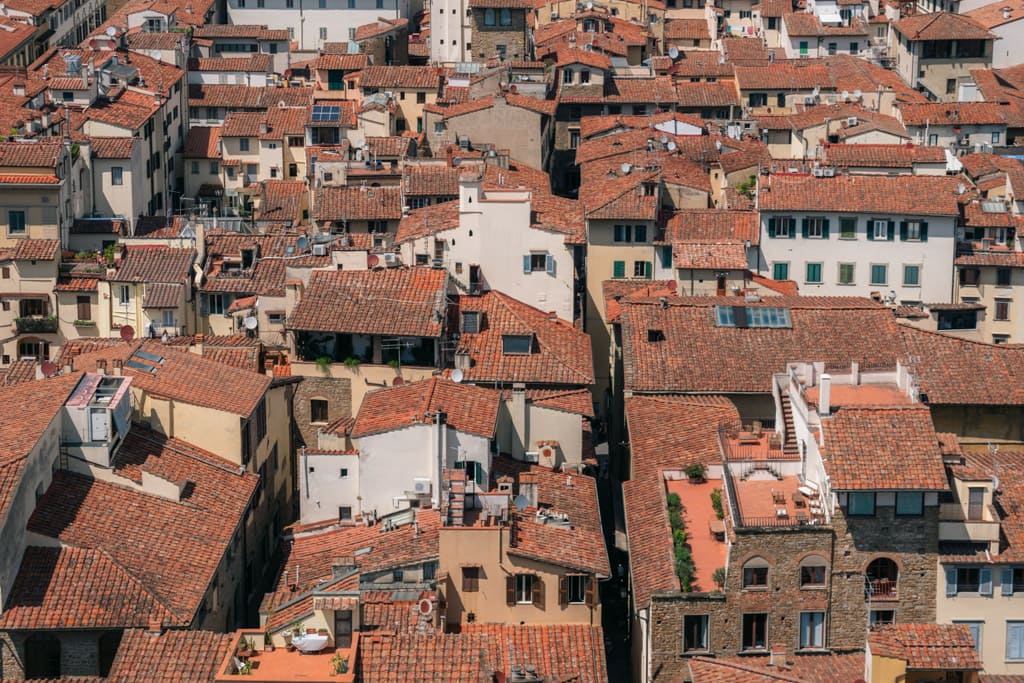
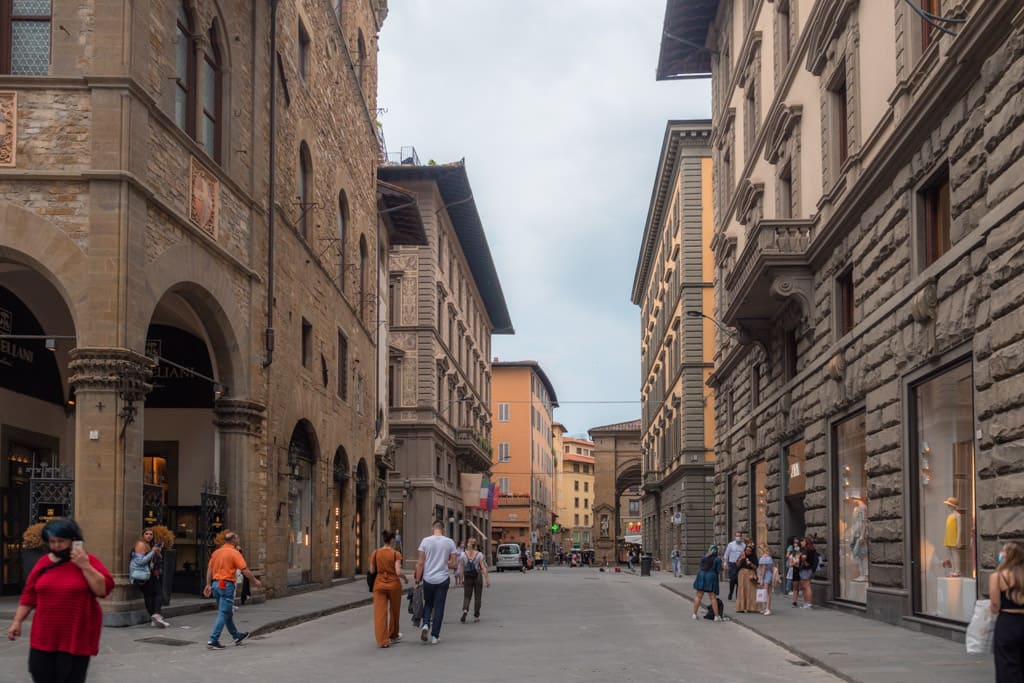


2. Il Duomo – The iconic cathedral of Florence
You’ve probably already seen pictures of the famous Il Duomo (officially Cattedrale di Santa Maria del Fiore); Florence’s iconic cathedral.
It’s truly impressive!
The dome, the tower and all the incredible details make it one of the most beautiful churches we have ever seen (perhaps along with the cathedral in nearby Siena and St. Peter’s Basilica in Rome).
The Gothic church, built between 1296 and 1436, is the most stunning from the outside, but we also think it is worth going inside.
It’s free to enter the Duomo, but as it’s one of the most popular things to do in Florence, be prepared for a long line. Or come first thing in the morning (preferably before it opens) to avoid the worst mid-day crowds.
Accessing the cathedral’s roof, museum or bell tower (Campanile di Giotto) requires a small fee.
Tip: Dress respectfully – you may be refused entry if you have bare shoulders and/or show too much leg above the knees.
Advertisement
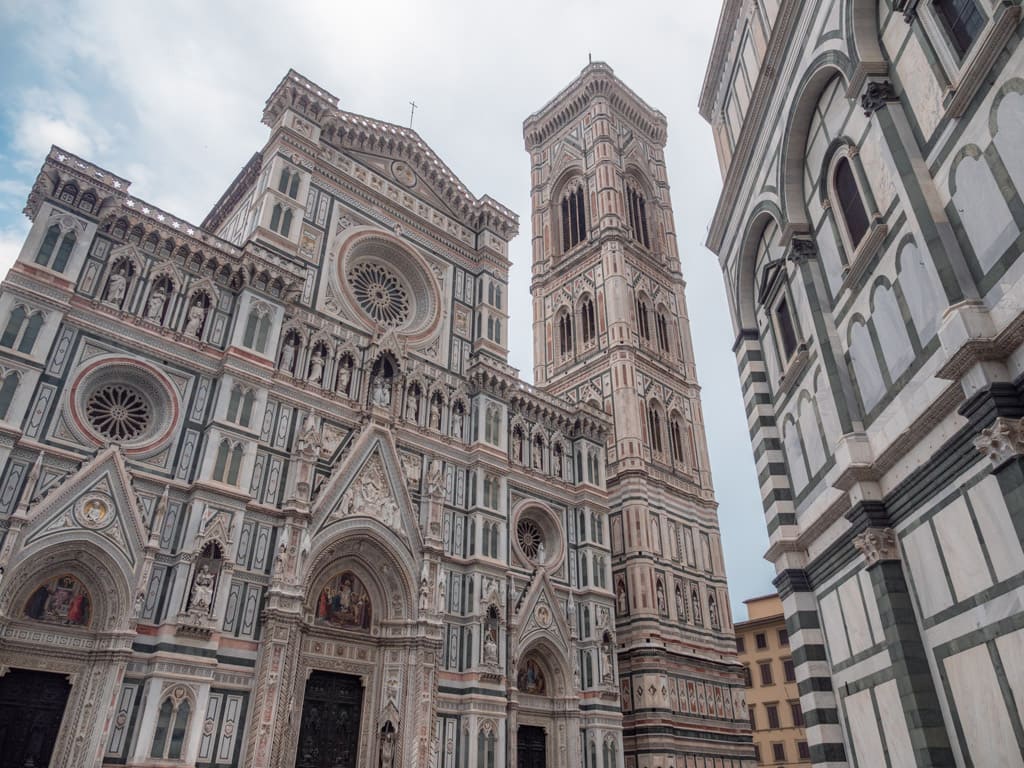






3. Palazzo Vecchio – A city hall with a panoramic view
Located in the picturesque square Piazza della Signoria, you’ll discover Florence’s town hall Palazzo Vecchio (the old palace).
The unique building is from 1540 (but dates all the way back to 1299), and it is particularly known for the Arnolfo Tower (Torre di Arnolfo), which rises high above the city’s rooftops.
Naturally, we ascended the tower to behold the breathtaking panoramic vista of Florence – an unforgettable experience.
As mentioned, you can also climb the cathedral’s tower, but access to the Arnolfo tower is cheaper (we paid 12.5 euro per person in 2022 which is around 13.5 USD) and from here you can actually see the entire cathedral.
Entrance to the Museum of Palazzo Vecchio and the Arnolfo Tower is included in the Firenze Card (adlink).
Advertisement







4. Piazza della Signoria – Beautiful square with a replica of Michelangelo’s David
The square in front of Palazzo Vecchio, Piazza della Signoria, is a must-see in Florence.
And you will most likely pass by the square quite naturally.
Situated centrally, it’s just a short stroll from both the Ponte Vecchio Bridge and the Galleria degli Uffizi (two of the most popular attractions in Florence).
Piazza della Signoria is one of the most beautiful squares in Florence – and probably the most famous.
In addition to restaurants, cafes and shops, you will also find a lot of statues, a replica of Michelangelo’s David and the big, fascinating Fountain of Neptune.




5. Ponte Vecchio – Historic bridge with coloured houses
Spanning the Arno River, the historic stone bridge known as Ponte Vecchio (old bridge) links the Palazzo Vecchio district in the Centro Storico with the Palazzo Pitti and Santo Spirito areas in Oltrarno.
The bridge is one of the most famous things to see in Florence, and of course, you have to see it too.
While the current Ponte Vecchio dates back to 1345, its origins are believed to trace all the way back to Roman times.
Remarkably, it stands as the sole surviving bridge in Florence from World War II, adding to its historical significance.
The bridge is not only stunning to behold from the water and neighbouring bridges like Ponte Santa Trinita and Ponte alle Grazie, but it also offers a unique experience to stroll across, immersing oneself in the charming array of small shops and street entertainment.




6. Piazzale Michaelangelo – The best view of Florence
One of the best things to do in Florence is seeing the breathtaking view of the city from Piazzale Michelangelo (and it won’t cost you a dime).
The viewpoint is on a hill south of the Arno River a little east of Palazzo Pitti.
Ascending the steep stairs requires a bit of effort, but the reward is well worth it. Alternatively, you can take bus 12 or 13.
We timed our visit with the sunset and although we were certainly not alone, it was truly magical.
At the top, you can see several of the city’s iconic landmarks alongside a bronze replica of Michelangelo’s David statue.
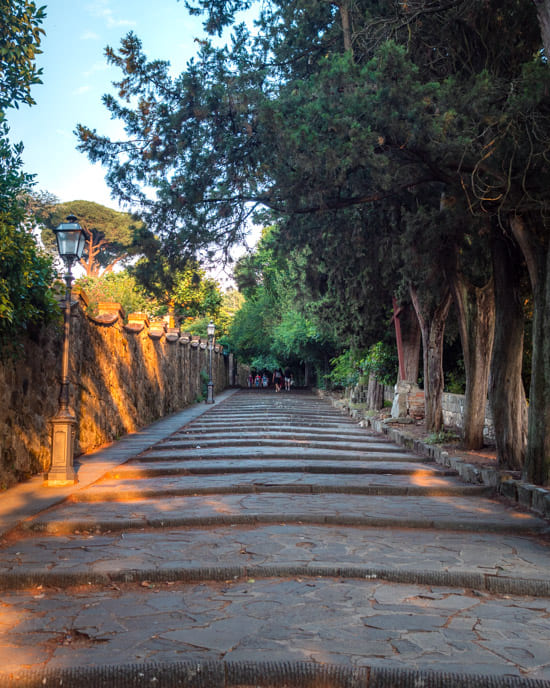



7. Basilica di San Miniato – Pretty church with a view
Following your visit to Piazzale Michelangelo, we highly recommend ascending a bit further to reach the small but charming Basilica di San Miniato.
Here, you can enjoy expansive views extending far beyond Florence in multiple directions, with notably fewer crowds compared to the bustling square below.
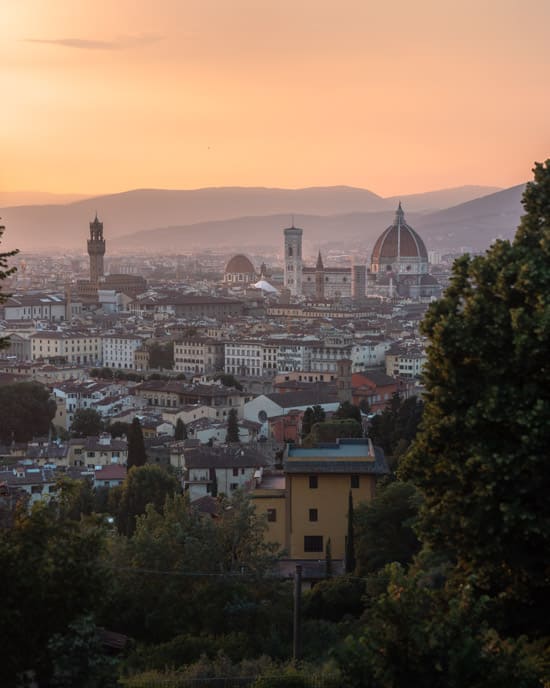






8. Galleria degli Uffizi – Italy’s most popular museum
Italy’s most popular museum, Galleria degli Uffizi, has a really large collection of Renaissance paintings.
Like many of Florence’s other buildings, the museum itself is a masterpiece.
At the Galleria degli Uffizi hangs, among other artworks, one of the world’s most famous Renaissance paintings; The Birth of Venus (in Italian: Nascita di Venere), as well as other great works by Botticelli, Da Vinci, Michelangelo, Caravaggio and many more.
The museum offers a captivating experience, and we highly recommend visiting it.
You can end up waiting for several hours if you just turn up on the day during the high season in summer. Because the Galleria degli Uffizi is so popular, we would advise people to buy tickets in advance or arrive early in the day.
The entrance to the museum is included in Firenze Card (adlink).
Advertisement






9. Galleria dell’Accademia – Say hello to the original David
Florence truly is a city of museums, and if you’re even slightly interested in art, you’ve probably heard of Michelangelo’s world-famous statue of David.
The more than 5-metre-high masterpiece from 1504 is found in the Galleria dell’Accademia. Of course, we couldn’t resist paying our respects to it.
We bought our tickets at the door for 12 euro per person (~ 13 USD) as we arrived at a time without a queue. You can see prices on the museum website here or book a fixed time and get priority access here (adlink).
Access to the Galleria dell’Accademia is included in the Firenze Card (adlink).

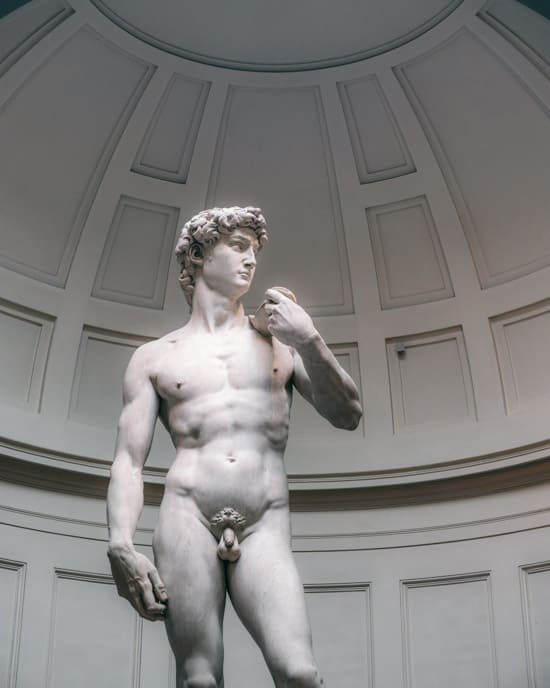

Advertisement
10. Palazzo Pitti – Renaissance Palace in the Boboli Gardens
The Renaissance Palace Palazzo Pitti was built for the Pitti family in 1457 and we almost skipped it because there is so much to see in Florence.
Nevertheless, we decided to go there in combination with visiting the Boboli Gardens (as detailed below), and we are glad we did. It was truly breathtaking!
The palace houses several museums, including the Palatina gallery, the Galleria d’arte moderna and museums for clothes, porcelain and silver.
Victoria loves historic palaces and the Palazzo Pitti did not disappoint.
The price to enter the palace is 16 euro (~ 17.3 USD), and the ticket can be bought here (adlink).
There are also combi tickets (adlink) where you also get access to the Boboli Gardens, Galleria degli Uffizi and/or other galleries. See below.
Advertisement



11. Giardino di Boboli – Florence’s green oasis
The Giardino di Boboli is a nice park adjacent to Palazzo Pitti (tickets are required for the individual attractions or you can buy a combi ticket).
The green oasis is perfect for a little break from the busy city, and you can admire the many sculptures and fountains in peace.
Considering how pompous the palace was, we found the Boboli Gardens somewhat underwhelming. Nonetheless, we’d still recommend a walk through the park if you have the time.
Use our adlinks to buy a ticket to the Boboli Gardens here or see the different combi tickets here.




Advertisement
12. Piazza di Santa Maria Novella – Cosy square with a beautiful church
Close to Florence’s big cathedral lies Piazza di Santa Maria Novella, home to the stunning (albeit slightly smaller) Santa Maria Novella Church.
The Gothic church from 1357 is known as one of the most spectacular of its kind, and it is clearly the main attraction in the square.
Tip: If you can afford it, we recommend looking into staying at 5-star The Place Firenze (adlink) which is located in Piazza di Santa Maria Novella.


13. Il Mercato Centrale – The San Lorenzo Market
The San Lorenzo Market (Mercato Centrale) is a large indoor historical food and produce market in the middle of Florence. It’s worth a visit if you need a little break from the many museums.
Here you can find fruit, vegetables, wine, olive oil and other delicacies from the Tuscany region.
On the top floor, a freshly prepared meal can be purchased; we had an amazing Neapolitan pizza marinara for lunch.
Around the building housing the food market, there’s an outdoor market offering a variety of items such as clothing, jewellery, ceramics and souvenirs.



14. Basilica di Santa Croce – The biggest Franciscan church in the world
Basilica of the Holy Cross (as Basilica di Santa Croce is also called) is not as popular as Il Duomo, but the beautiful church is still one of the most beautiful things to see in Florence.
Located on Piazza di Santa Croce only about 800 metres from the cathedral, it is easy to get to.
As the largest Franciscan church in the world, it is especially known for having 16 chapels where, for example, Michelangelo, Dante and Galileo are buried.

15. Eat gelato – Enjoy real Italian ice cream
You simply cannot visit Florence (and Italy in general) without eating the creamy Italian ice cream called gelato.
It tastes better than “regular” ice cream, and we have to admit that we try to eat at least one gelato every day when we are in Italy.
We especially liked Eduardo Gelateria, located right next to Il Duomo. You would think that a location next to the most famous attraction in Florence would mean high prices and low quality, but this is definitely not the case. Their gelato was excellent!

16. The best day trips from Florence
Although Rome is formally the capital of Italy, it’s not difficult to argue that Florence is far more central. The city in fact served as the country’s capital from 1865 to 1870.
Within a relatively short distance of Florence, you can visit a multitude of small and large cities, all of which offer staggering amounts of history, art and, not least, fantastic food.
Here are the most prominent cities to consider for day trips from Florence:
- Bologna. With a train journey of only approximately 37 minutes, it would be a shame to overlook one of Italy’s other big city gems.
- Siena. 1 hour and 15 minutes by bus or 1 hour and 30 minutes by train to one of Tuscany’s absolute prettiest cities.
- Pisa. It’s just under an hour by train to the world-famous Leaning Tower of Pisa.
- Lucca. In an hour and a half by train, you can reach the charming medieval city of Lucca known for its intact ancient city wall.
- San Gimignano. The Town of Fine Towers is small but very atmospheric, and you can get there by train in approximately 1 hour and 20 minutes.
- Prato and Pistoia. In approximately half an hour you can take the train to either Prato or Pistoia, both of which are a kind of extension of Florence. They are known as beautiful Tuscan towns with far fewer tourists than Florence.
Advertisement



Map of the best things to do and see in Florence
Here is a map of all the mentioned experiences and sights in Florence.
Where to stay in Florence
Let’s just say it right away: It’s quite expensive to stay in Florence.
Even if you visit Tuscany’s capital outside the tourist season, don’t expect to find particularly cheap accommodation.
Depending on the neighbourhood you choose, there are hotels available at a range of prices that can accommodate most budgets.
Generally, you can spend the night in three different areas in Florence:
- In the historic centre (Centro Storico).
- South of the Arno River (Oltrarno).
- Outside the centre.
The historic centre:
For travellers spending just a few days in Florence, staying in the historic centre (or just on its outskirts) is ideal. Here, you’re within close proximity to all the major attractions and getting around on foot is convenient.
The prices in this area are on average the highest, but in return, you also get bang for your buck when you wake up with a view of Il Duomo.
South of the Arno River:
Staying south of the Arno River in Oltrarno is also a great choice.
You’re still near the city centre and have access to a variety of dining options, but it may be slightly more budget-friendly compared to staying in the heart of the city, as you’re a bit further from the main attractions.
Outside the centre:
If you’re looking to save money, considering hotels located entirely outside the city centre might be a sensible option.
You can typically find more affordable accommodations if you’re willing to take a short train or bus ride into Florence.
Additionally, there are budget-friendly options within walking distance of the Centro Storico, such as around Santa Maria Novella main station. Just be prepared to walk a bit more each day compared to staying directly in the city centre, and note that not all streets in this area are equally charming.
We have written a travel guide to the best hotels and areas in Florence, where you can read more about the neighbourhoods and where we stayed in Florence.
Our favourites: Where to stay in Florence?
- Luxury: The Place Firenze – An absolutely exquisite 5-star hotel with the city’s best location.
- Value for money: Drom Florence Rooms & Apartments – Spacious rooms in cosy Oltrarno with nice green surroundings.
- Budget: Poggio Baronti B&B – From here, it’s a 20-minute bus ride into Florence. In return, you will get a cheap and comfortable stay.
Search for the cheapest and best hotels in Florence here.
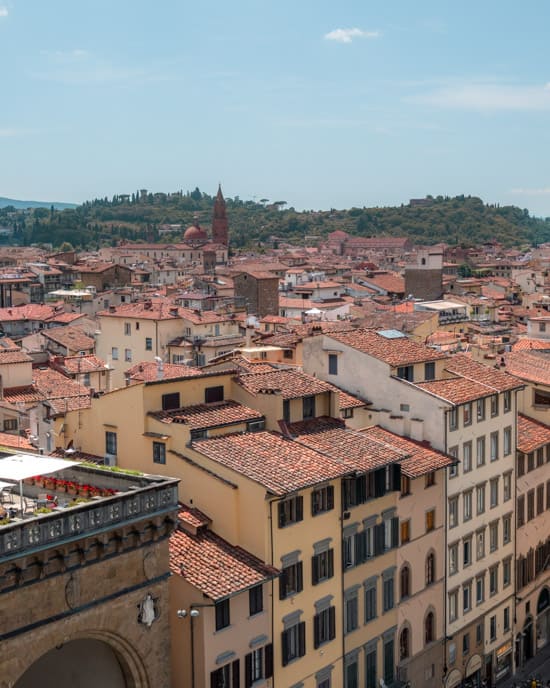

The best luxury hotels in Florence:
- Ultra luxury: The St. Regis Florence – Live like the royals with a view of the Arno River.
- Luxury: The Place Firenze – An absolutely exquisite 5-star hotel with the city’s best location.
- Luxury: Villa Cora – Pompous villa from the 19th century with a pool in Oltrarno.




The best value for money hotels in Florence:
- Value for money: Drom Florence Rooms & Apartments – Spacious rooms in cosy Oltrarno with nice green surroundings.
- Value for money: Antica Dimora Sant’Anna – Budget-friendly double rooms in San Lorenzo north of the Centro Storico.

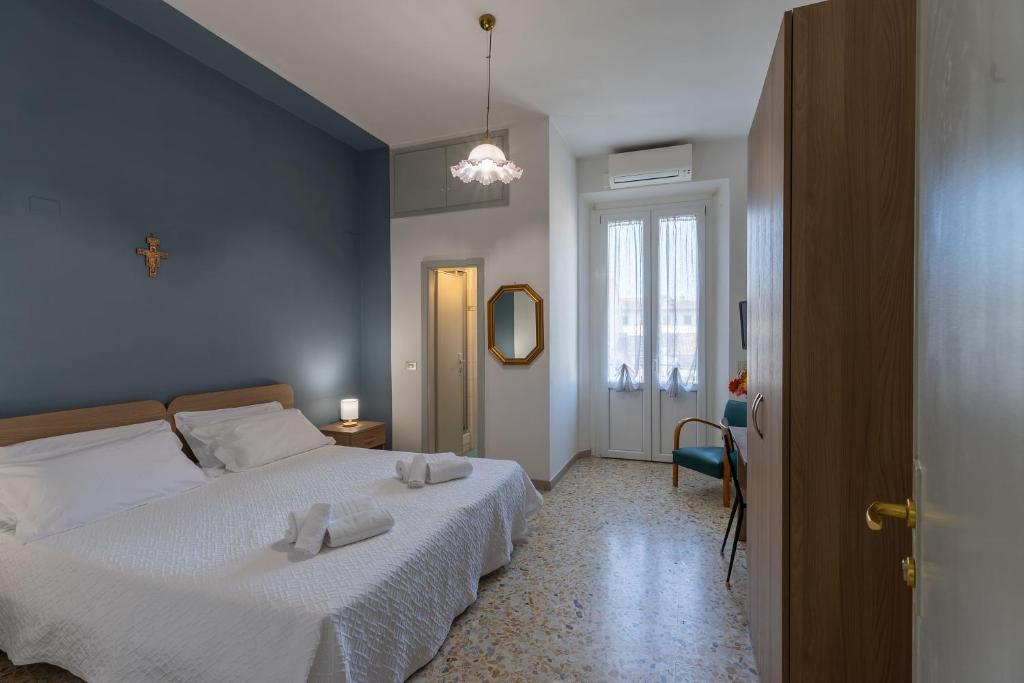
The best budget hotels in Florence:
- Budget: Poggio Baronti B&B – From here, it’s a 20-minute bus ride into Florence. In return, you will get a cheap and comfortable stay.
- Budget: Dimora Salviati – Save money by living (beautifully!) in Florence’s hills north of the centre.




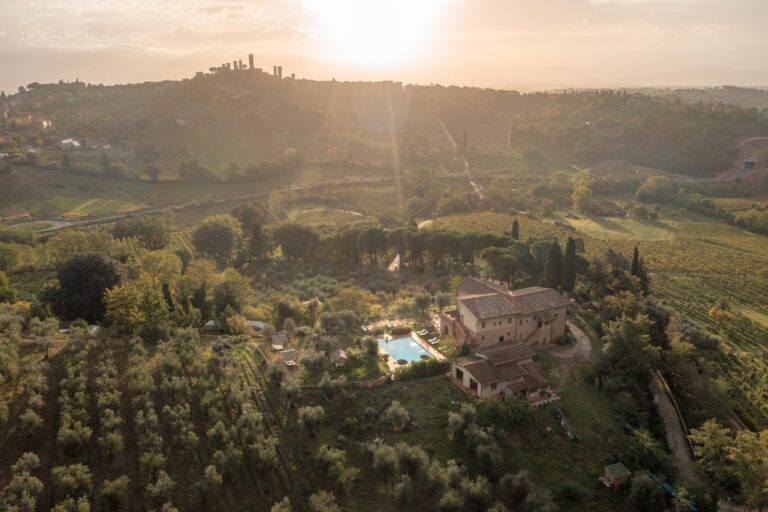
Best restaurants and cafés in Florence
La Pépinière Ristorante Biologico
La Pépinière Ristorante Biologico is a charming restaurant where you can have a delicious dinner at very fair prices.
The restaurant is organic and vegan, and here we got some fantastic pizzas with “parmesan” and “ricotta” for dinner.
We can also recommend the “parmesan pieces” with rice syrup for starters.

Il Vegano Bistrot
The small café Il Vegano Bistrot offers excellent food at remarkably affordable prices, particularly considering it is organic.
Among other things, you can get burgers, risotto, various types of pasta and spaghetti, soup, lasagna and desserts. A perfect place for a little lunch.
We had a tasty piece of lasagna and a panini with aubergine for lunch as well as a “cheesecake” and a creamy tiramisu (which was not so tiramisu-like, but still good).
In addition to everything being vegan, several dishes are gluten-free.

Eduardo Gelateria
Gelato (creamy Italian ice cream) is one of the best things we know!
And when in Italy, indulging in a gelato or two (or three or four…) is an absolute must.
We had heard good things about Eduardo Gelateria, but since it is right next to the touristy cathedral, we have to admit that we had low expectations.
We were pleasantly surprised!
It was the best gelato we had in Florence.
We shared a cone with four scoops with bacio (chocolate/hazelnut), fondente (dark chocolate) and pistachio. We can easily recommend it.

Perché no!
Another great gelateria is Perché no! (translates to “why not”), located on a cosy little street.
The gelateria has a great selection and we were happy they had vegan options.
We tried hazelnut (always delicious!), chocolate and coconut.

Il Mercato Centrale
In an earlier section of the guide, we wrote about the expansive food market San Lorenzo (Il Mercato Centrale), renowned for its array of fresh produce and gourmet delights on the ground floor, with meal options available for purchase on the upper level.
It’s a great place to eat lunch or grab a quick snack to keep up the energy during an eventful day in Florence.
We got a perfect Neapolitan pizza marinara.

Flower Burger
The vegan chain Flower Burger is worth trying, even if you don’t eat plant-based.
Their sinful burgers are available in several colours, and although they may not be the colours you associate with burgers, don’t be intimidated. Children might even find it fun to choose a brightly coloured burger.
We loved their “cheesy cecio” with chickpea steak and tartare dressing as well as their classic Flower Burger with a bean/seitan steak and BBQ dressing. Their choco-love (lava cake) was also a hit.
The prices are also more than reasonable.


Nirvana
Nirvana is a cosy establishment exuding a spiritual ambience inspired by Indian and Thai culture, featuring murals and tranquil meditation music.
While the restaurant is a bit drawn back from the historic centre, we had the pleasure of savouring a delicious vegan spaghetti carbonara outdoors.
Their pizza with three (vegan) cheeses and extra eggplant was quite good and crispy, but not necessarily worth a detour.
Although the coffee wasn’t the best, the chocolate-pear cake was a delightful conclusion to our lunch.

Universo Vegano
Next to a nice green square, you will find Universo Vegano, which is another vegan restaurant we tried in Florence.
They have a lot of fun desserts on display, but instead, we splurged on pumpkin ravioli and enchiladas (Mexican tortillas with sauce), both of which tasted good.
The atmosphere is quite casual and you are required to order your food at the counter and collect it yourself. While the service wasn’t the friendliest, it could have been just an off day for the staff.
Nonetheless, we thoroughly enjoyed the charming ambience of the square outside where we dined.

SimBIOsi Organic Cafe
The organic café is conveniently located next to the Galleria dell’Accademia, offering a fantastic cup of coffee.
We shared a large cappuccino with oat milk and a V60 with Brazilian coffee. Both quenched the coffee thirst.
Unfortunately, we can’t recommend their açai bowl, which was too runny, and the bread in their avocado toast was quite dry – so better stick to the coffee.

How to get around Florence
Walk
Florence is an ideal city for exploring on foot, which is primarily how we navigated during our visit.
You’ll rarely walk more than 30 minutes between major attractions due to the compact layout of the city.
It feels safe walking and there are well-maintained sidewalks. However, it’s important to remain cautious of traffic, as it can be quite busy and occasionally chaotic.
Public transport
If the distance between point A and point B is a bit far to walk, you can conveniently use one of the nearly 100 bus lines or three tram lines available in the city.
Buy tickets at the stops/stations, inside the buses and in some convenience stores – and remember to validate them when you get on.

Car and parking in Florence
We drove to Florence on a road trip through Italy (where we had just lived in Sardinia for more than 6 months), but unless you also plan to drive through Tuscany, we would not recommend renting a car.
There is a lot of traffic in Florence and few (and expensive) parking spaces.
Furthermore, the entire historic district of the city is designated as a “zona a traffico limitato” (ZTL), meaning it’s a restricted traffic area with specific regulations for driving and parking. However, access is typically permitted for bicycles, electric cars, motorcycles, and scooters.
Surveillance cameras are in place, and hefty fines can be incurred for violating the regulations.
Read more about the ZTL rules here.

Long-term parking
After unloading our luggage, we drove to a free parking lot next to the Centro commerciale Ponte a Greve and parked there all the time we were in town.
You can also take a look at Parcheggio Autostradale “Drive and Tramway” on the A1 motorway, from which you can easily enter the centre of Florence by public transport.
Several hotels in Florence offer parking (for a relatively high price), or you can check parking lots on Google Maps and see if there are any free, unlimited parking spots near where you will be staying. However, don’t count on that if you live centrally.
Although we did not experience any problems with break-ins, we would still recommend that you do not leave anything of value in the car.
How to get to Florence
Car to Florence
Italy’s primary motorway, the A1, passes directly by Florence, making it easy to access the city by car.
However, we advise against driving into the city centre due to congestion, limited parking and the ZTL we mentioned above.
Public transport to Florence
There are regular train connections to Florence Central Station (Santa Maria Novella) from the rest of Italy.
From the Central Station, you can easily walk to your hotel if it is centrally located, or you can continue by bus or tram.
Flights to Florence
There are two airports you can fly to when visiting Florence:
- Amerigo Vespucci Airport (FLR), also known as Peretola, is less than 10 kilometres from Florence. From here, you can get into Florence by public transport in approximately 20 minutes.
- Pisa International Airport (PSA), also known as Galileo Galilei, is located approximately 80 km from Florence, but is sometimes cheaper to fly to than Peretola. The trip by train to Florence takes around 1 hour and 20 minutes.
Search for flights to Florence on Momondo here (adlink).

When to visit Florence
Florence can be visited all year round and tourists flock to the city regardless of the season.
The high season is in July and August when Italians, Europeans and much of the rest of the world enjoy their summer holidays.
July and August are also the hottest months, so if you have the flexibility to plan your trip to Florence outside of this period, we strongly recommend doing so.
June and September are good shoulder months with great weather and fewer crowds, although there are still many tourists.
December, January and February are the coldest months (like many other places in Europe).
It rains the most in October, November and December.
Note: On June 24th every year, the San Giovanni Festival is celebrated and large parts of Florence close (including access to the cathedral).


Our weather experience in Florence
We visited Florence in June and enjoyed the fantastic weather. There were of course quite a few tourists, but nowhere near how many there are in the middle of summer.
September is also a good time to visit Florence.
In September 2022, we visited several other cities in Tuscany close to Florence (among others Lucca, Siena and Pisa), and the temperatures and crowds were at a comfortable level.


Our best tips for visiting Florence
- Pre-order tickets online so you avoid spending time queuing for ticket sales at various museums and palaces. Alternatively, buy a Firenze Card (adlink) to skip the queues.
- Arrive early or late in the day at the most popular attractions to avoid the long queues that typically occur in the middle of the day.
- Many restaurants close for siesta between lunch and dinner, so keep an eye on the opening hours if you want to eat at a particular restaurant or café during the day.
- Expect an additional charge on the restaurant bill. Most restaurants add a “coperto” per guest, which is a fee per person regardless of your order. It is typically between 1 and 3 euros, which you pay in addition to the price of the food. It’s common to receive a small bread basket with butter or olive oil and balsamic vinegar as a starter.


What to bring to Florence
- Travel insurance (adlink). Never travel without it!
- A good camera – here’s a guide to the gear we use.
- Sunscreen. Especially if you visit Florence in the summer. We recommend an organic, vegan sunscreen without oxybenzone and other harmful chemicals.
- Sneakers or other types of shoes you can walk in comfortably.
- A refillable water bottle.



Sustainable travel tips
To travel as sustainably as possible, we recommend the following:
- Bring your own drinking water in a refillable bottle.
- Avoid disposable plastics.
- Sort your waste correctly and do not throw it on the ground.

Thank you for reading
Thank you for reading our travel guide to Florence. We hope it has been helpful!
What do you think of Florence?
If you’ve already been to Tuscany’s stunning capital, it would be great to hear your best tips and tricks on what to do and see.
Don’t hesitate to ask us anything in the comments below if you haven’t been to Florence yet. We are happy to help.
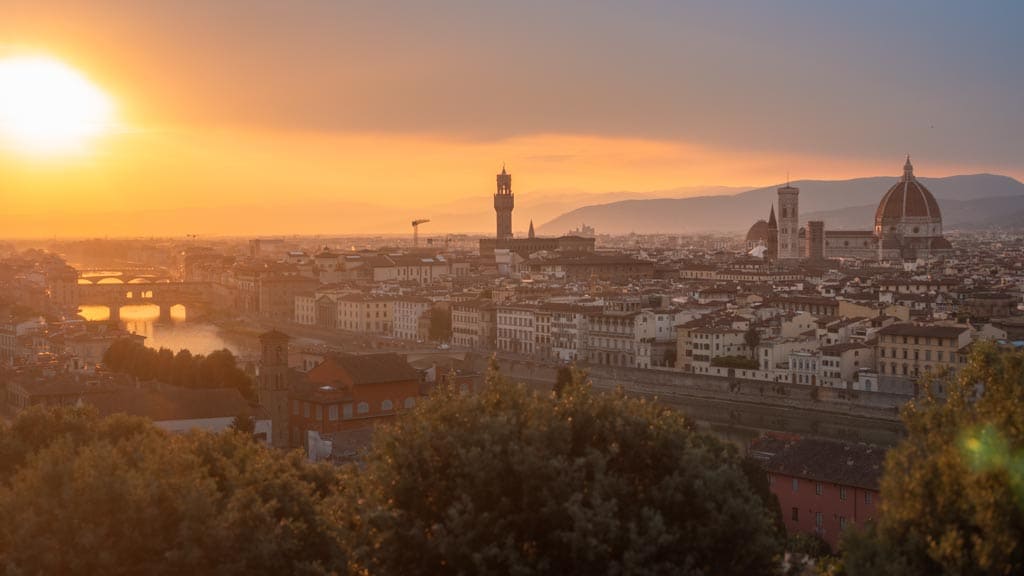
Our favourite travel resources:
- Booking.com for cheap hotels.
- Momondo for the best flight deals.
- SafetyWing for travel insurance. We also like World Nomads and True Traveller. All three compared here.
Our camera gear:
- Panasonic GH5. Used for all of our photos and videos.
- DJI Mavic 2 Pro. Best drone out there!
- Sirui Tripod. Lightweight and strong.
- See all of our camera gear here.



 Book cheap hotels
Book cheap hotels  Find the best flight deals
Find the best flight deals  Nomad insurance
Nomad insurance  Our Camera Gear
Our Camera Gear Our Packing List
Our Packing List
I would love to visit Florence. The cathedral is absolutely stunning! Thank you for sharing all this great information.
Florence is such a beautiful city, and the cathedral really is one of those places that *just has* to be seen in person. We hope you get to go!